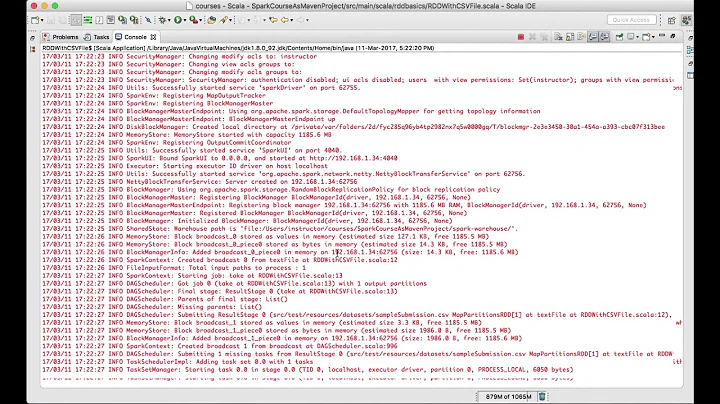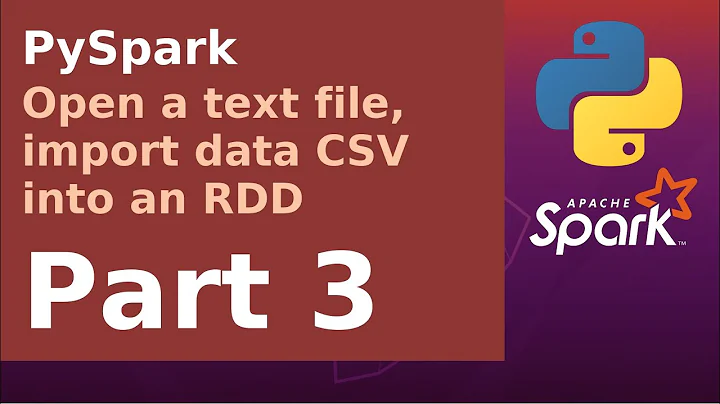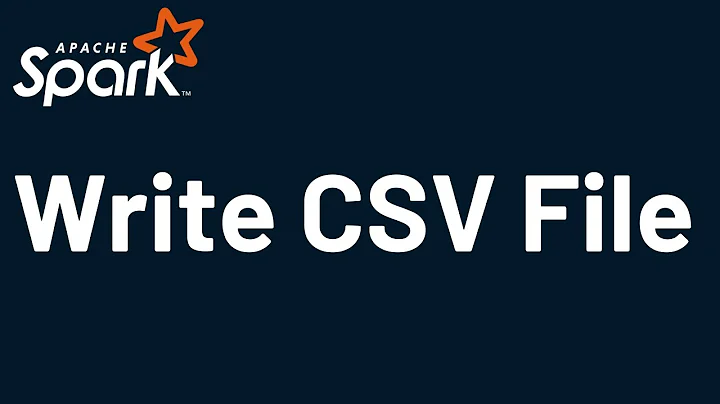How to write the resulting RDD to a csv file in Spark python
Solution 1
Just map the lines of the RDD (labelsAndPredictions) into strings (the lines of the CSV) then use rdd.saveAsTextFile().
def toCSVLine(data):
return ','.join(str(d) for d in data)
lines = labelsAndPredictions.map(toCSVLine)
lines.saveAsTextFile('hdfs://my-node:9000/tmp/labels-and-predictions.csv')
Solution 2
I know this is an old post. But to help someone searching for the same, here's how I write a two column RDD to a single CSV file in PySpark 1.6.2
The RDD:
>>> rdd.take(5)
[(73342, u'cells'), (62861, u'cell'), (61714, u'studies'), (61377, u'aim'), (60168, u'clinical')]
Now the code:
# First I convert the RDD to dataframe
from pyspark import SparkContext
df = sqlContext.createDataFrame(rdd, ['count', 'word'])
The DF:
>>> df.show()
+-----+-----------+
|count| word|
+-----+-----------+
|73342| cells|
|62861| cell|
|61714| studies|
|61377| aim|
|60168| clinical|
|59275| 2|
|59221| 1|
|58274| data|
|58087|development|
|56579| cancer|
|50243| disease|
|49817| provided|
|49216| specific|
|48857| health|
|48536| study|
|47827| project|
|45573|description|
|45455| applicant|
|44739| program|
|44522| patients|
+-----+-----------+
only showing top 20 rows
Now write to CSV
# Write CSV (I have HDFS storage)
df.coalesce(1).write.format('com.databricks.spark.csv').options(header='true').save('file:///home/username/csv_out')
P.S: I am just a beginner learning from posts here in Stackoverflow. So I don't know whether this is the best way. But it worked for me and I hope it will help someone!
Solution 3
It's not good to just join by commas because if fields contain commas, they won't be properly quoted, e.g. ','.join(['a', 'b', '1,2,3', 'c']) gives you a,b,1,2,3,c when you'd want a,b,"1,2,3",c. Instead, you should use Python's csv module to convert each list in the RDD to a properly-formatted csv string:
# python 3
import csv, io
def list_to_csv_str(x):
"""Given a list of strings, returns a properly-csv-formatted string."""
output = io.StringIO("")
csv.writer(output).writerow(x)
return output.getvalue().strip() # remove extra newline
# ... do stuff with your rdd ...
rdd = rdd.map(list_to_csv_str)
rdd.saveAsTextFile("output_directory")
Since the csv module only writes to file objects, we have to create an empty "file" with io.StringIO("") and tell the csv.writer to write the csv-formatted string into it. Then, we use output.getvalue() to get the string we just wrote to the "file". To make this code work with Python 2, just replace io with the StringIO module.
If you're using the Spark DataFrames API, you can also look into the DataBricks save function, which has a csv format.
Related videos on Youtube
Jason Donnald
Updated on July 09, 2022Comments
-
Jason Donnald almost 2 years
I have a resulting RDD
labelsAndPredictions = testData.map(lambda lp: lp.label).zip(predictions). This has output in this format:[(0.0, 0.08482142857142858), (0.0, 0.11442786069651742),.....]What I want is to create a CSV file with one column for
labels(the first part of the tuple in above output) and one forpredictions(second part of tuple output). But I don't know how to write to a CSV file in Spark using Python.How can I create a CSV file with the above output?
-
Jason Donnald over 8 yearsJust as a doubt, so where will this save the
csvfile? In the same directory as where the code is present?Can I save it to other directory (usingsaveAsTextFile('/home/files/labels-and-predictions.csv'))? -
Daniel Darabos over 8 yearsYou can use any path the Hadoop client library understands. Typically it will be a path on a distributed file system. I've updated the example to illustrate this. But if you're just testing on one machine, you can use a local path as well.
-
Jason Donnald over 8 yearsI tried to use it but when I execute it creates a directory named 'labels-and-predictions.csv' and inside that directory there are two files - _SUCCESS and part-00000
-
Daniel Darabos over 8 yearsYeah, that's the output. It will be split into multiple files if the RDD is made up of multiple partitions. Is this a problem for you? This is perfectly normal and desired in big data use cases.
-
Jason Donnald over 8 yearsso to read this csv file again somewhere else in ipython I just need to put the 'labels-and-predictions.csv' and all the part files inside that will be read automatically?
-
Daniel Darabos over 8 yearsIt depends on the tool. Hadoop tools will read all the
part-xxxfiles. Spark will also read it when you usesc.textFile. For conventional tools you may need to merge the data into a single file first. If the output is small enough to be handled by conventional tools though, there is no reason to save it via Spark. Justcollectthe RDD and write the data to a local file without Spark. -
 Moe Chughtai over 7 yearsI get a TypeError using this code. TypeError: can't write str to text stream.
Moe Chughtai over 7 yearsI get a TypeError using this code. TypeError: can't write str to text stream. -
 Galen Long over 7 years@Moe Chughtai Which version of Spark/Python are you using? Which line gives you the type error, and on what input?
Galen Long over 7 years@Moe Chughtai Which version of Spark/Python are you using? Which line gives you the type error, and on what input? -
Quetzalcoatl almost 7 yearsIt doesn't seem standard to assume that a .csv extension in the destination path guarantees that csv will be written, as illustrated in the 5th comment above. It seems more common that protocols involved with hdfs and s3 may encrypt and compress the output resulting in a non-csv file.
-
Andrew over 6 yearsI had to encode some columns w/ JSON but otherwise this works
-
Jie about 2 years@lnsiloco, how to write this to a Snowflake or a Redshift database? Thanks!








